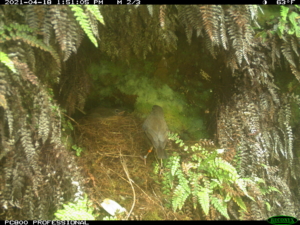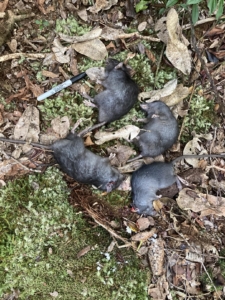A few weeks ago, staff members Hannah Landwerlen and Evan checked a Puaiohi nest that they have been monitoring in the Alaka’i and found that the nestling and the female were killed by a predator. When Field Leader, Justin Hite first started this job in 2015, he went to check that same nest and also found the female torn to pieces. These kind of events are particularly difficult for the staff at KFBRP, because their positions here are way more than just jobs. The staff at KFBRP cares deeply about the fate of these birds. This is why they do the work that they do, camping in miserable, damp conditions for weeks on end, hiking in steep, uneven terrain and spending countless hours working to save the birds that still remain.
This article was written by Justin in 2015, but I wanted to include it on the blog today because it is still so significant considering the extinction crisis faced by many of Kaua’i’s forest birds.
In a Rain of Song, by Justin Hite
The thick throaty song of a Small Kauai Thrush stopped me in my tracks. Each phrase was a faithful rendition of his four-syllabled Hawaiian name: Puaiohi. He was close, his voice like a clarinet under honey, and perched directly above his mate’s nest. I smiled in her direction, wondering if she loves his singing as much as I do. It’s hard to tell what an incubating bird is thinking about. All you see is that cute little face peeking out of the extravagance of the nest, in this case a small throne cupped on a cascade of fibers pouring out of a crevice in a giant fern-draped wall of rock.
When a bird sings it’s so easy to get caught up in the richness and beauty and imagination of it. Effortlessly I projected emotions to him. The song seemed a carefree salute to his misty domain, of joyousness toward his worldly needs. Of berries ripening in the forest. The texture of bark. The crisp beauty of his rocky stream. Even to the pouring rain that muffled his dauntless voice.
A few days later, soaked and cheerful, I made my way down into the narrow gorge that led past the same nest. I could hear him from a distance—it was the same song, suggesting all the same easily-projected wonders onto my naïve mind. I pondered the miracle of his continued existence, a species numbering fewer than 500, proudly carrying on ancient birdy traditions in the highest, most remote, wettest chasms of Kauai. I rounded the last bend and looked up at the nest. It was a ruin of moss and blood-specked feathers, a single disembodied wing resting neatly beside the top of the nest. A rat had found her. And she had either been caught unaware or maybe stayed and tried to defend her helpless eggs. But she lost. The singing male lost. Maybe we all lost.
I almost felt angry, but that fizzled. Instead I just felt exhausted. Defeated. These birds are so rare. This didn’t need to happen.
I stood there for a long time.
And the male kept singing. It was the same song it had always been. And I don’t have any idea what it means.
If you are interested in learning more about how KFBRP combats the predator problem in the Alaka’i check out the following articles:
- 124 A24s – Weapons to Fight Rats
- NC State University Explains Why KFBRP’s “Birds, Not Rats!” Campaign Successful
- Midweek Features Birds not Rats Campaign
- Threats to Birds
If you are interested in helping KFBRP combat the rat problem, please click the donate button in the upper right corner of the page.





 Robby Kohley
Robby Kohley